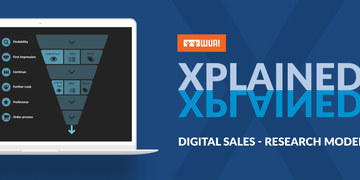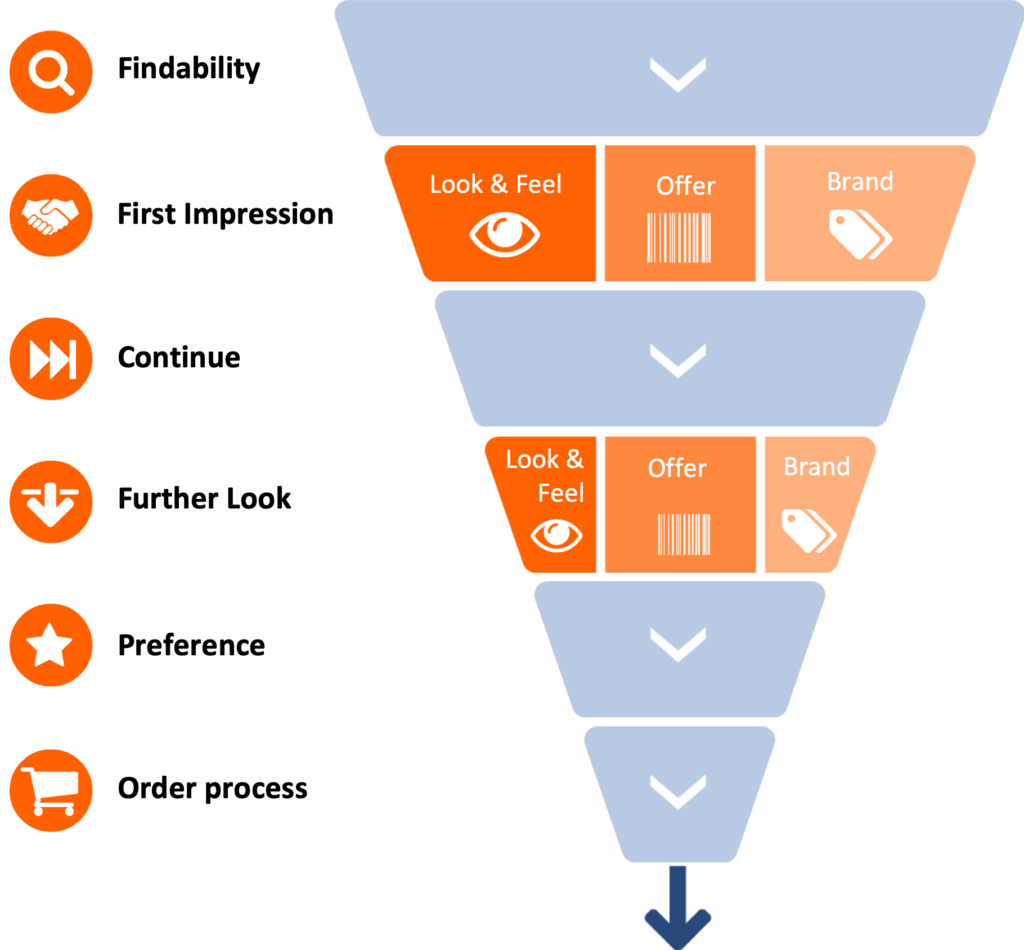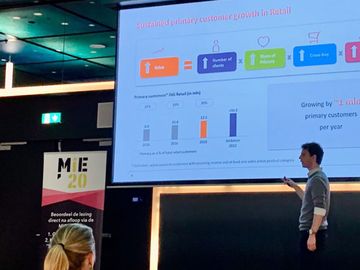
WUA Xplained #2: The Digital Sales Model
WUA has been extensively researching digital sales customer journeys for more than 15 years. These journeys can highly vary in their nature: they differ in the goal of the consumer, the product the consumer is looking for and the market in which a customer journey takes place.
WUA has conducted studies in the Insurance market (e.g.: home or car insurance), Telecom (sim only, mobile phone and plan), Finance (credit card, personal loan, investment banking) to name just a few industries and journeys. However, one element of these journeys tends to be universal: the main phases involved. WUA has captured these phases in the Digital Sales Model, which forms the basis of every customer experience study WUA carries out for digital sales journeys. This article will show you the ‘building blocks’ of the Digital Sales Model, and why researching every phase involved is crucial to gain insight in a customer journey.
From Findability to Preference (and beyond)
In a nutshell, the Digital Sales Model consists of 6 consecutive phases that take place during the customer journey (see an image of the model below):
1 – Findability
Are consumers able to find your website while searching for a product? If so, through which route?
2 – First Impression
How do consumers evaluate the first 0-60 seconds on your website?
3 – Continue
Are consumers willing to further explore your website, based on their first impression?
4 – Further Look
How do consumers assess your website on a deeper level, while fully exploring the presented content, pricing, and offer?
5 – Preference
After comparing multiple websites, do consumers ultimately choose your website to buy/apply for the desired product?
6 – Order/Application Process
After choosing your website, how do consumers evaluate the process of ordering/applying for the desired product?
The Digital Sales Model and its corresponding 6 phases are incorporated in the standardized questionnaire that we use in our customer experience studies. Output from this questionnaire reveals how consumers go through these phases on any given website and/or app.
Let’s take a closer look at each of these phases.

The WUA Digital Sales Model consists of three themes in both the First Impression and the Further Look phase of the customer journey. Per phase, all three themes consist of a set of open-ended and closed questions on information, products offered, contact options and brand image.
Phase 1: Findability
Many customer journeys start with consumers freely searching for websites that might suit their needs. We define Findability as the percentage of respondents who have landed on your website during their orientation on a particular product. They could potentially visit your website via a search engine or by entering the URL directly – the latter happening more often at companies with a large brand-awareness. For the ‘search engine group’, it is of vital importance to have a good SEA (paid links at the top of search results) and SEO (natural placement of links) in place. This way, you can effectively guide orienting consumers towards your website. No Findability, no customer journey.
Phase 2: First Impression
Once consumers have landed on your website, they immediately start forming an impression. What do they see? Is it relevant? What kind of company is behind this website? The First Impression phase is a crucial step in the journey, because it sets the stage for the whole customer experience. To capture this impression, we ask respondents both open-ended and closed questions. We do this to acquire qualitative comments and quantitative scores, respectively. These questions can be fit within 3 separate themes:
Look & Feel
The technical operation of the website and the way the products and services are shown. Does the way the website works make sense? Can consumers find the most relevant information at a single glance? Does the website look attractive to the visitor?
Offer
Includes everything that has to do with a provider’s product or service. This is not just the number of products and prices, but also about how easy it is for the visitor to find the options relevant to them. Immediately after arriving on the website, the thoughts that the visitor forms – the idea that the products they’re looking for can be found here – needs to be confirmed.
Brand
An online consumer wants to feel the company behind the website is trustworthy. In order to be taken seriously, a brand needs to make sure there are no contradictions in the way it presents itself. Successful brands have a consistent, credible, relevant, clear promise, and take good care of its customers. A part of this is being open to contact and dialogue.
Phase 3: Continue
Based on the immediate impression they formed, consumers express whether they think it’s worth their time and effort to continue exploring your website to find the product that they need. If so, your website is one step closer to converting the visitor. If not, you will lose interest of the visitor and thus the chance to motivate him or her to choose your product.
Phase 4: Further Look
Once consumers have decided that your website is worth a more thorough exploration, they will interact with the corresponding content and elements more extensively. In the Further Look phase, the three themes of the First Impression (Look & Feel, Offer and Brand) reappear but are now researched in much more detail.
Phase 5: Preference
Having gone through the previous customer journey phases on different websites, consumers assess which website stands out positively. They do so by evaluating and comparing these websites, considering aspects that formed a part of their overall experience: information, navigation, design, products, brand proposition, etc. Ultimately, consumers choose one website to buy their product on.Moreover, the respondents express their #2, #3, and #4 choice, and state what these websites should improve to become number 1 in their personal ranking. We define Preference of a website as an absolute percentage of respondents that see that website as their number 1 choice for buying the product.
Phase 6: Order Process
Once consumers actively decide to buy the product on your website, they initiate the order process. It is important to make this final step of the online journey as easy and intuitive as possible for consumers, so that their previous positive experiences with your website remain intact. At WUA, we see the Order Process as a ‘hygiene factor’ that must be convenient and smooth at all times. The Order Process is disconnected from the previous steps of the funnel, because it is evaluated after the Preference phase. Therefore, the Order Process phase has no influence on the overall preference statements of consumers.
The Digital Sales Model & Benchmarking
In conclusion, the Digital Sales Model captures all the phases a consumer goes through when looking for a product online. By integrating these phases in our standardized customer experience questionnaire, we can effectively compare evaluations of sales journeys within and between various markets and industries, on a national but also on an international level. Interested? Find out more about our global CX Benchmark in the next edition of WUA Xplained: WUA Xplained #3: The Digital Sales Model – Advanced.


